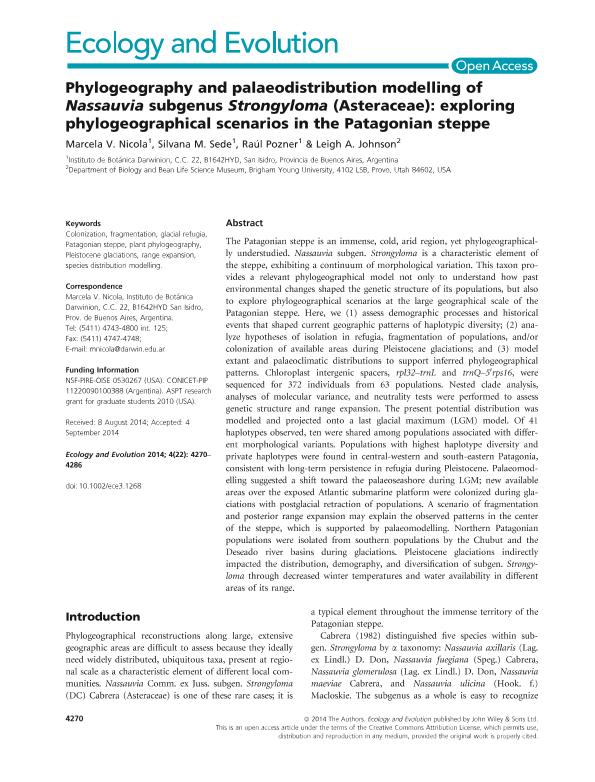Artículo
Phylogeography and palaeodistribution modelling of Nassauvia subgenus Strongyloma (Asteraceae): exploring phylogeographical scenarios in the Patagonian steppe
Fecha de publicación:
11/2014
Editorial:
Wiley
Revista:
Ecology and Evolution
e-ISSN:
2045-7758
Idioma:
Inglés
Tipo de recurso:
Artículo publicado
Clasificación temática:
Resumen
The Patagonian steppe is an immense, cold, arid region, yet phylogeographically understudied. Nassauvia subgen. Strongyloma is a characteristic element of the steppe, exhibiting a continuum of morphological variation. This taxon provides a relevant phylogeographical model not only to understand how past environmental changes shaped the genetic structure of its populations, but also to explore phylogeographical scenarios at the large geographical scale of the Patagonian steppe. Here, we (1) assess demographic processes and historical events that shaped current geographic patterns of haplotypic diversity; (2) analyze hypotheses of isolation in refugia, fragmentation of populations, and/or colonization of available areas during Pleistocene glaciations; and (3) model extant and palaeoclimatic distributions to support inferred phylogeographical patterns. Chloroplast intergenic spacers, rpl32–trnL and trnQ–5′rps16, were sequenced for 372 individuals from 63 populations. Nested clade analysis, analyses of molecular variance, and neutrality tests were performed to assess genetic structure and range expansion. The present potential distribution was modelled and projected onto a last glacial maximum (LGM) model. Of 41 haplotypes observed, ten were shared among populations associated with different morphological variants. Populations with highest haplotype diversity and private haplotypes were found in central-western and south-eastern Patagonia, consistent with long-term persistence in refugia during Pleistocene. Palaeomodelling suggested a shift toward the palaeoseashore during LGM; new available areas over the exposed Atlantic submarine platform were colonized during glaciations with postglacial retraction of populations. A scenario of fragmentation and posterior range expansion may explain the observed patterns in the center of the steppe, which is supported by palaeomodelling. Northern Patagonian populations were isolated from southern populations by the Chubut and the Deseado river basins during glaciations. Pleistocene glaciations indirectly impacted the distribution, demography, and diversification of subgen. Strongyloma through decreased winter temperatures and water availability in different areas of its range.
Archivos asociados
Licencia
Identificadores
Colecciones
Articulos(IBODA)
Articulos de INST.DE BOTANICA DARWINION (I)
Articulos de INST.DE BOTANICA DARWINION (I)
Citación
Nicola, Marcela Viviana; Nicola, Marcela Viviana; Pozner, Raul Ernesto; Johnson, Leigh; Phylogeography and palaeodistribution modelling of Nassauvia subgenus Strongyloma (Asteraceae): exploring phylogeographical scenarios in the Patagonian steppe; Wiley; Ecology and Evolution; 4; 22; 11-2014; 4270-4286
Compartir
Altmétricas




